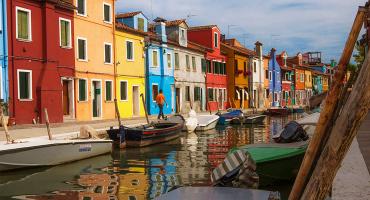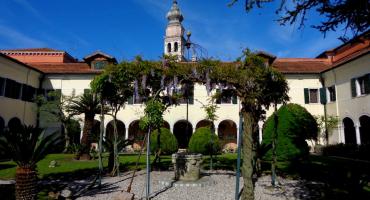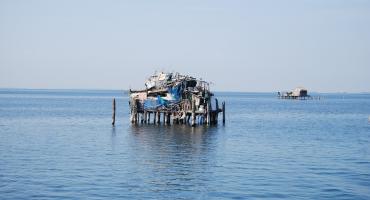History and tradition of the Island of Sant’Erasmo: between land, sea, and sky
Away from the crowds of Piazza San Marco and the gondolas gliding along the canals, there lies a lesser-known gem of the Venetian lagoon: the lush island of Sant’Erasmo.
This large islet, the biggest in the lagoon, located a few kilometers from Venice, has always been a flora and fauna gem, a truly naturalistic place characterized by the lagoon ecosystem. Its highly fertile soil and unique exposure to sea water and sunlight have turned the agricultural work of its inhabitants into a true source of knowledge and flavors. This has also physically shaped the Venetian lagoon and its boundaries, allowing us to appreciate sunrises, sunsets, and landscapes of absolute beauty even today.
First: some history highlights
The island of Sant’Erasmo is first mentioned in the 10th century AD in the "Chronicon Gradense" (1032), where it is described as the Litus Mercedis, with a church dedicated to Saints Hermes and Erasmus, protectors of sailors. Before the Cavallino coastline took its current form, Sant’Erasmo served as a natural barrier between the lagoon and the Adriatic, highlighting the dynamic interaction between land and sea.
In the Middle Age, Sant’Erasmo was an important port for Murano and Torcello and a key supplier of agricultural products to Venice. Thanks to its fertile lands and favorable climatic conditions, the isle has given for centuries fresh products to match the food needs of Venetians and continues to supply them to the Rialto Market even today, although to a lesser extent.
In the 1700s, the island suffered significant population losses due to epidemics and the fall of the Serenissima Republic. Under French and then Austrian control, Sant’Erasmo became a strategic military location, with the construction of the Massimiliana Tower (1843/44) and other defensive structures.
During World War II, the island and its tower were used as a defense line by the Germans. After the war, the tower became a refuge for displaced people and an agricultural warehouse. It was only in the 1990s that the tower was restored and converted into a historical site and event venue, now enlivening the island and attracting many curious visitors.
And Today...
Today, Sant’Erasmo remains a serene and green refuge, home to a close-knit community of 700 inhabitants. These dedicated residents keep their rich agricultural heritage alive, warmly welcoming visitors to explore the island’s lush gardens and vineyards.
The significance of this lagoon environment allows for numerous activities: you could have a walk immersed in the sounds of nature, losing yourself in a unique atmosphere between land, water, and sky, also you could rent a bike and tour the entire perimeter of the island admiring the lagoon and the nearby islands.
But, in all honesty, even if you just want to relax and breathe the sea air, you can enjoy beaches and long green stretches, savoring local products and dining at local restaurants like the famous "Al Bacan."
For food enthusiasts, the highlight of the year is in May, when the famous Sant’Erasmo Violet Artichoke Festival takes place, featuring markets, musical events, and cultural activities. This unique and characteristic product of the island is highly appreciated for its sweet taste and smell. Its strange and intriguing violet color makes it a perfect ingredient both for flavor and aesthetics.
The artichoke season on Sant’Erasmo begins at the end of April with the harvest of the "Castraure", the first apical shoots, available for only 10/15 days a year. If you are lucky enough to visit the island in spring, you might find, taste, and buy them. During the festival in May, local organizations open to the public, guiding visitors through the farms, offering traditional dishes at a food stand, and providing entertainment for both children and adults with activities like archery and theatrical performances.
In October, the island gathers for the Festa del Mosto, dedicated to the first wine produced after the grape harvest: torbolino. This rustic, slightly sparkling wine pairs perfectly with local delicacies, and the festival features tastings and various performances to entertain both adults and children.
Gardens and vineyards allow Sant’Erasmo to maintain its agricultural vocation and preserve this serene and "slow" environment where time seems to have stood still. The community, with its vibrant spirit, regularly organizes events and photographic exhibitions that celebrate and enhance local traditions. These events attract visitors from all over the world, helping to keep ancient traditions alive and passing down agricultural knowledge to new generations.
Visiting the island and tasting its products, talking to the residents and those who work every day to keep the local tradition alive, allows you to enter another dimension, more authentic and genuine.
So, seize the opportunity to visit Sant’Erasmo along with the beauties of the lagoon and its islands, breathe in the essence of these magical places, and discover the culture and traditions of this land and sea community.
How to get to Sant'Erasmo?
From Venice, take the water-bus, Line 13 from the stop "Fondamenta Nove" to Sant'Erasmo. Duration: 30 minutes.
TAG
Categories



